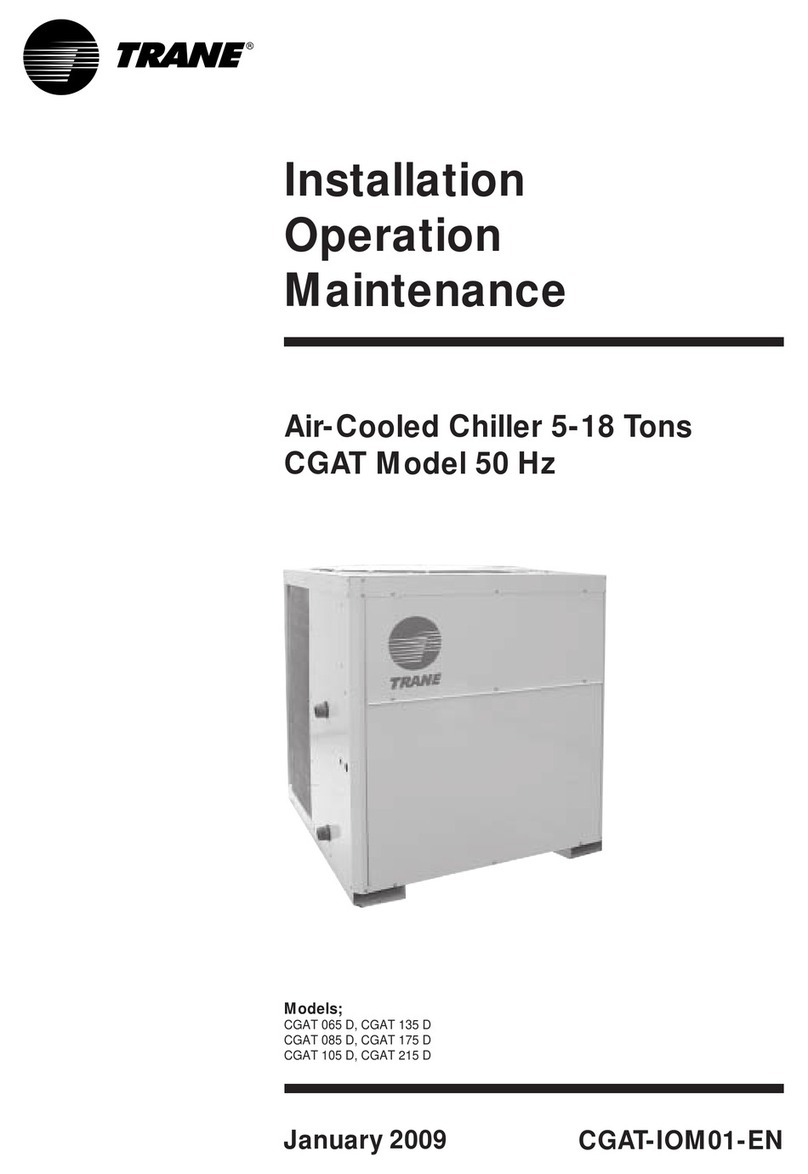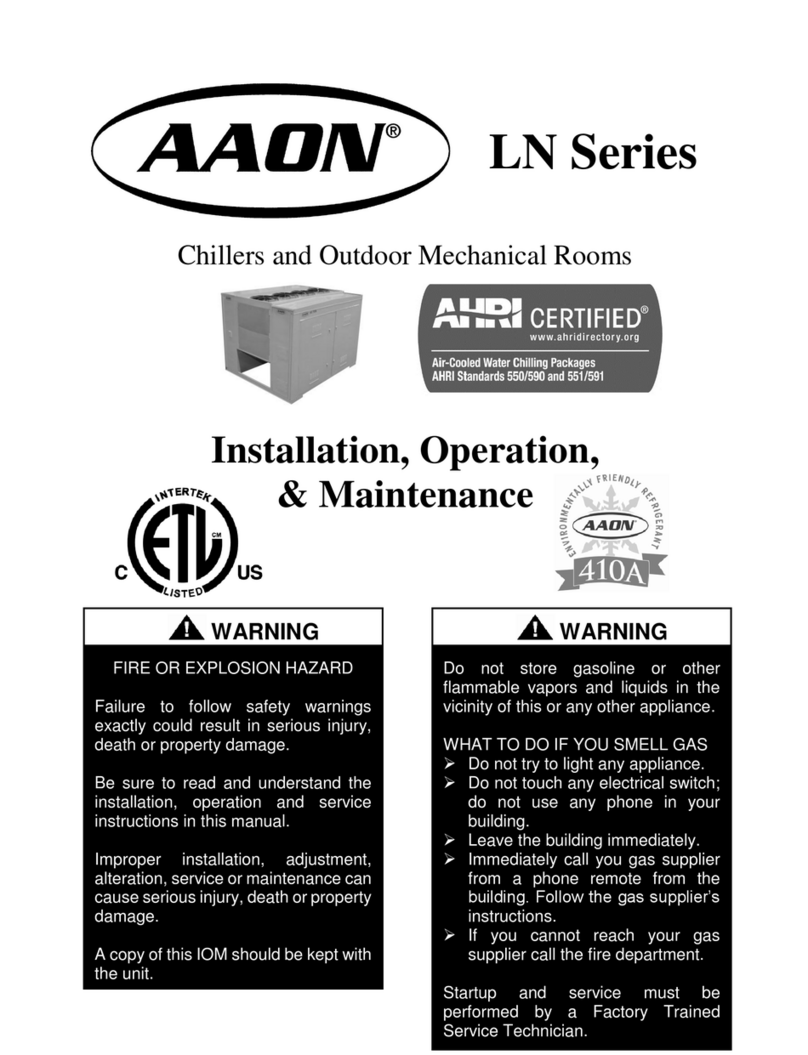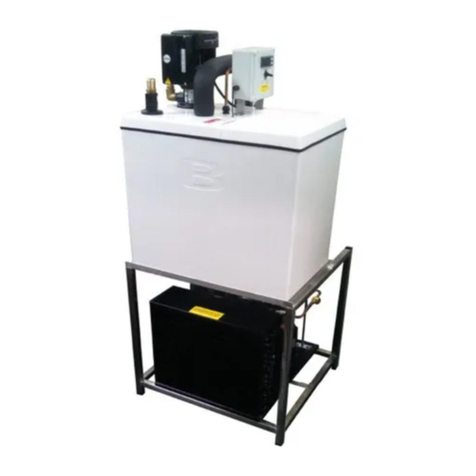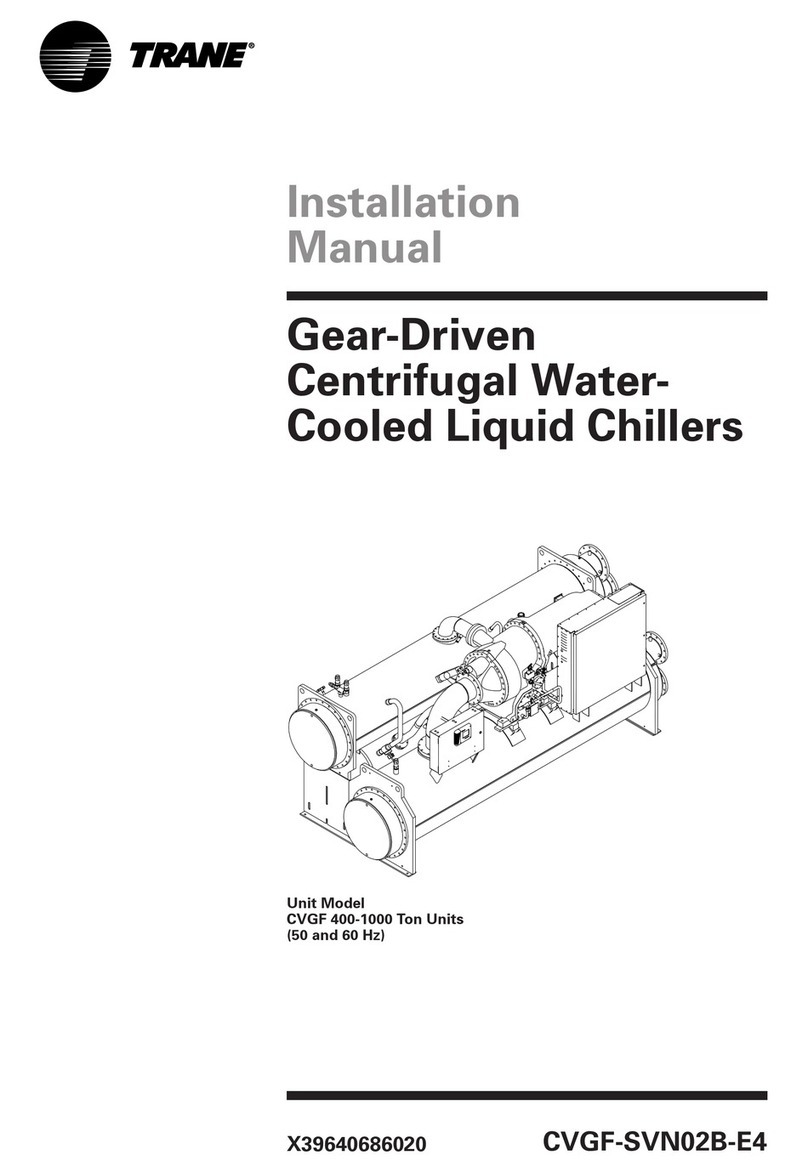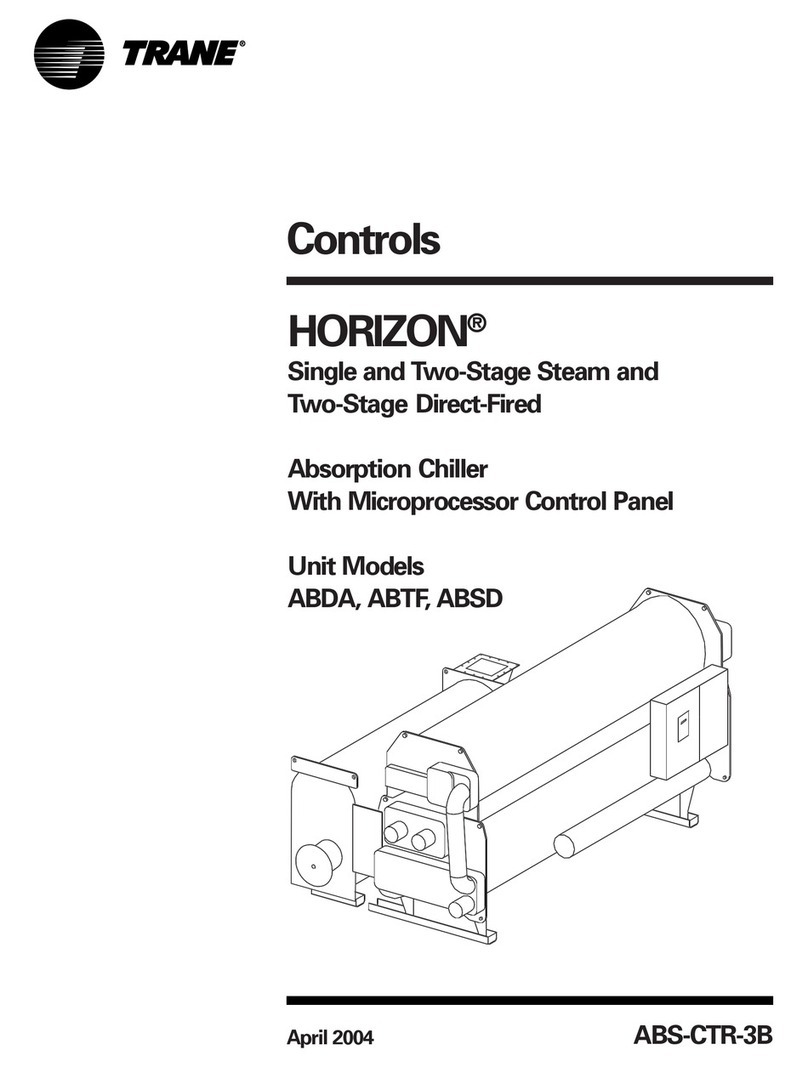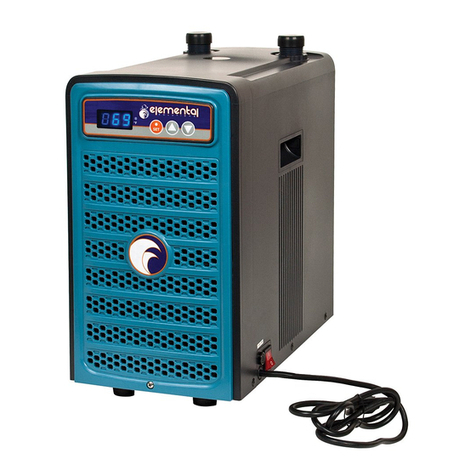HIdRos WSA Series User manual

Multiple instructions:
Consult the specific part
Read and understand
the instructions before
undertaking any work on
the unit
RETAIN FOR FUTURE REFERENCE
Incorporated in this document are the following:
• Declaration of conformity
• Technical manual
• Dimensional drawing
• Wiring diagrams
TECHNICAL MANUAL
WATER CHILLERS
WSA
SERIES
MTEC.3800.GB-B-1 Operation and maintenance WSA series English Rev. 07-2013 Original Instructions

Rev. B 07-2013
2
MTEC.3800.GB-B-1 Operation and maintenance WSA series English
WSA Water chiller
Reproduction, data storage and transmission, even partial, of this publication, in any form, without the prior written authorisation of HIDROS
S.p.A., is prohibited. HIDROS S.p.A. can be contacted for all inquiries regarding the use of its products.
HIDROS S.p.A. follows a policy of continuous product development and improvement and reserves the right to modify specifications, equi-
pment and instructions regarding use and maintenance at any time, without notice.
Declaration of conformity
We declare under our own responsibility that the below equipment complies in all parts with the CEE and EN directives.
The declaration of conformity is enclosed to the technical booklet enclosed with the unit.

Rev. B 07-2013
3
MTEC.3800.GB-B-1 Operation and maintenance WSA series English
WSA Water chiller
INDEX
1. INTRODUCTION................................................................................................................................................................................... 5
1.1 Preliminary information.................................................................................................................................................... 5
1.2 Aim and content of the manual ....................................................................................................................................... 5
1.3 How to store this manual ................................................................................................................................................. 5
1.4 Manual updates ............................................................................................................................................................... 5
1.5 How to use this manual ................................................................................................................................................... 5
1.6 Potential risks .................................................................................................................................................................. 6
1.7 General description of symbols used............................................................................................................................... 7
1.8 Safety symbols used........................................................................................................................................................ 8
1.9 Limitations and prohibited use......................................................................................................................................... 9
1.10 Unit identification .......................................................................................................................................................... 9
2. SAFETY ............................................................................................................................................................................................. 10
2.1 Warning re potentially hazardous toxic substances ...................................................................................................... 10
2.2 Refrigerant handling ..................................................................................................................................................... 10
2.3 Prevention of inhalation of high vapor concentrations................................................................................................... 11
2.4 Procedures in the event of accidental release of refrigerant ......................................................................................... 11
2.5 Main Toxicological information on the type of refrigerant used...................................................................................... 11
2.6 First aid measures ......................................................................................................................................................... 11
3. TECHNICAL CHARACTERISTICS ..................................................................................................................................................... 12
3.1 Unit description.............................................................................................................................................................. 12
3.2 Other versions ............................................................................................................................................................... 14
3.3 Accessories description ................................................................................................................................................. 14
3.4 Technical data................................................................................................................................................................ 15
3.5 Operation limits.............................................................................................................................................................. 19
3.6 Correction tables............................................................................................................................................................ 20
3.7 Sound data .................................................................................................................................................................... 21
4. INSTALLATION ................................................................................................................................................................................... 21
4.1 General safety guidelines and and use of symbols ....................................................................................................... 21
4.2 Workers’ health and safety ........................................................................................................................................... 22
4.3 Personal protective equipment ..................................................................................................................................... 22
4.4 Inspection ...................................................................................................................................................................... 22
4.5 Storage .......................................................................................................................................................................... 23
4.6 Unpacking...................................................................................................................................................................... 23
4.7 Lifting and handling........................................................................................................................................................ 23
4.8 PLocation and minimum technical clearances............................................................................................................... 24
4.9 Installation of rubber vibration dampers (KAVG) ........................................................................................................... 25
4.10 Serial interface card RS485 (INSE)............................................................................................................................. 25
4.11 Source water pump installation.................................................................................................................................... 26
4.12 Hydraulic connections.................................................................................................................................................. 26
4.13 Chemical characteristics of the water.......................................................................................................................... 27
4.14 User circuit minimum water content............................................................................................................................. 27
4.15 Installation with source open circuit (reversible version) .............................................................................................28
4.16 Chemical characteristics of groundwater..................................................................................................................... 28
4.17 Hydraulic components ................................................................................................................................................. 29
4.18 Filling the hydraulic circuit............................................................................................................................................ 32
4.19 Emptying the installation.............................................................................................................................................. 32
4.20 WSA/EV Refrigerant connections................................................................................................................................ 33
4.21 Wiring connections: Preliminary safety information..................................................................................................... 35
4.22 Electric data................................................................................................................................................................. 36
4.23 Electric connections..................................................................................................................................................... 37
4.24 Refrigerant circuit layout.............................................................................................................................................. 38
5. UNIT START UP.................................................................................................................................................................................. 40
5.1 Preliminary Checks........................................................................................................................................................ 40
5.2 Description of the control panel ..................................................................................................................................... 42
5.3 Remote control panel .................................................................................................................................................... 43

Rev. B 07-2013
4
MTEC.3800.GB-B-1 Operation and maintenance WSA series English
WSA Water chiller
6. USE. ...... ............................................................................................................................................................................................ 45
6.1 Switch the unit on .......................................................................................................................................................... 45
6.2 Stop ............................................................................................................................................................................... 46
6.3 Stand-by ........................................................................................................................................................................ 46
6.4 How to change the set points ........................................................................................................................................ 46
6.5 Parameters list .............................................................................................................................................................. 47
6.6 Acoustic signal silencing ................................................................................................................................................ 47
6.7 Alarm reset..................................................................................................................................................................... 47
6.8 Display alarm history .....................................................................................................................................................47
7. MAINTENANCE OF THE UNIT........................................................................................................................................................... 48
7.1 General warnings........................................................................................................................................................... 48
7.2 Access to the unit........................................................................................................................................................... 48
7.3 Periodical checks........................................................................................................................................................... 48
7.4 Refrigerant circuit repair ................................................................................................................................................49
8. DECOMMISSIONING.......................................................................................................................................................................... 50
8.1 Unit Isolation & drain down............................................................................................................................................ 50
8.2 Disposal, recovery and recycling .................................................................................................................................. 50
8.3 RAEE directive (only for EC countries).......................................................................................................................... 50
9. DIAGNOSIS & TROUBLESHOOTING................................................................................................................................................ 50
9.1 Fault finding .................................................................................................................................................................. 50
10. DIMENSIONAL DRAWINGS ............................................................................................................................................................. 52

Rev. B 07-2013
5
MTEC.3800.GB-B-1 Operation and maintenance WSA series English
WSA Water chiller
1. INTRODUCTION
1.1 Preliminary information
1.2 Aim and content of the manual
1.3 How to store this manual
1.4 Manual Update
1.5 How to use this manual
Reproduction, storage or transmission of any part of this publication in any form, without the prior written consent of the Company, is pro-
hibited.
The unit to which these instructions refer, is designed to be used for the the purposes described and to be operated in accordance with
these instructions.
The Company will not be liable for claims for damage caused to persons, animals, material goods or property caused by improper installa-
tion, adjustment and maintenance or improper use. Any use not specified in this manual is prohibited.
This document is intended to provide information only and does not form a contract with third parties.
The Company pursues a policy of constant improvement and development of its products and therefore reserves the right to change the
specifications and the documentation at any time, without notice and without obligation to update existing equipment.
These instructions are intended to provide the information required for the selection, installation, use and maintenance of the unit.
They have been prepared in accordance with the European Union laws and with the technical standards in force at the date of issue of the
instructions.
The instructions contain all the necessary information to prevent any reasonably foreseeable misuse.
The manual must be kept in a suitable place with easy access for users and operators, protected from dust and damp.
The manual must always accompany the unit during the entire life cycle of the same and therefore must be transferred to any subsequent
user.
It is recommended that the manual is updated to the latest revision available.
If updates are sent to the customer they must be added to this manual.
The latest information regarding the use of its products is available by contacting the Company.
The manual is an integral part of the unit.
Users or operators must consult the manual before performing any operation and especially so when transporting, han-
dling, installating, maintaining, or dismantling the unit in order to eliminate uncertainty and reduce risk.
In these instructions symbols have been used (described in the following paragraphs) to draw the attention of operators
and users to the operations that have a higher risk and which must be performed safely.

Rev. B 07-2013
6
MTEC.3800.GB-B-1 Operation and maintenance WSA series English
WSA Water chiller
1.6 Potential Risks
Whilst the unit has been designed to minimize any risk posed to the safety of people who will interact with it, it has not been technically
possible to eliminate completely the causes of risk. It is therefore necessary to refer to the requirements and symbolism below:
LOCATION OF
RISK POTENTIAL RISK METHOD OF INJURY PRECAUTIONS
Thermal heat
exchangers. Small stab wounds. Contact Avoid any contact,
use protective gloves.
Fan and fan grilles. Cuts, eye damage,
broken bones.
Insertion of sharp objects throu-
gh the grid while the fans are
operating.
Never put objects through the pro-
tection grilles.
Internal component:
compressors and
discharge pipes
Burns. Contact Avoid any contact, use protective
gloves.
Internal component:
electric cables and
metallic parts
Electrocution,
severe burns.
Defect in the supply cable in-
sulation, live metallic parts.
Adequate protection of power ca-
bles, ensure correct earthing of all
metal parts.
External to unit:
unit enclosure
Poisoning,
severe burns.
Fire due to short circuit or
overheating of the supply ca-
ble external to unit.
Size cables and mains protection
system in accordance with iee regu-
lations.
Low pressure safety
valve.
Poisoning,
severe burns.
High evaporating pressure
causing a refgrigerant dischar-
ge during maintenance.
Carefully check the evaporating
pressure during the maintenance
operations.
High pressure safety
valve.
Poisoning,
severe burns,
hearing loss.
Activation of the high pressure
safety valve with the refrige-
rant circuit open.
If possible, do not open the refri-
gerant circuit valve; carefuly check
the condensing pressure; use all
the personal protective equipment
required by law.

Rev. B 07-2013
7
MTEC.3800.GB-B-1 Operation and maintenance WSA series English
WSA Water chiller
BANNED
A black symbol inside a red circle with a red diagonal indicates an action that should not be performed.
WARNING
A black graphic symbol added to a yellow triangle with black edges indicates danger.
ACTION REQUIRED
A white symbol inserted in a blue circle indicates an action that must be done to avoid a risk.
The graphic symbol “warning” is qualified with additional safety information (text or other symbols).
Safety symbols combined in accordance with ISO 3864-2:
1.7 General Description of Symbols Used
Safety symbols combined in accordance with ISO 3864-2:

Rev. B 07-2013
8
MTEC.3800.GB-B-1 Operation and maintenance WSA series English
WSA Water chiller
GENERAL RISK
Observe all signs placed next to the pictogram. The failure to follow directions may create a risk situation that may
be injurious to the user.
ELECTRICAL HAZARD
Observe all signs placed next to the pictogram.
The symbol indicates components of the unit and actions described in this manual that could create an electrical
hazard.
MOVING PARTS
The symbol indicates those moving parts of the unit that could create risk.
HOT SURFACES
The symbol indicates those components with high surface temperature that could create risks.
SHARP SURFACES
The symbol indicates components or parts that could cause stab wounds.
EARTH CONNECTION
The symbol identifies Earthing connection points in the unit.
READ AND UNDERSTAND THE INSTRUCTIONS
Read and understand the instructions of the machine before any operations.
RECOVER OR RECYCLE MATERIAL
1.8 Safety symbols used

Rev. B 07-2013
9
Manufacturer: PD322111
Via E. Mattei, 20
35028 Piove di Sacco PD
Italy
Refrigeratore d'acqua/Water chiller
Kaltwassersatz/Refroidisseur à eau
Matricola/Serial number
Matrikel/Matricule
1WSA.031H-1A 283878
Tensione-Fasi-Frequenza
Voltage-Phases-Frequency
Spannung-Phasen-Frequenz
Tension-Phases-Fréquence
Corrente massima assorbita
Max absorbed current
Maximalstromverbrauch
Courant maxi absorbée
400V/3Ph+N/50Hz/PE 24 A
Tipo refrigerante
Refrigerant type
Kältemittel typ
Type de refrigerant
Carica refrigerante
Refrigerant charge
Kältemittelfüllung
Charge de refrigerant
R410A N.A.
Max press. di esercizio (alta/bassa)
Max allowable press. (high/low)
Max kältermit betriebsdrück (hoch/nieder)
Press. maxi admissible (haut/bas)
Data di produzione
Manufacturing date
Erstellungsdatum
Date de fabrication
41.5/22.1 18/01/2012
MTEC.3800.GB-B-1 Operation and maintenance WSA series English
WSA Water chiller
The unit is not suitable for operations in environments:
• excessively dusty or potentially explosive atmospheres;
• where there are vibrations;
• where there are electromagnetic fields;
• where there are aggressive atmospheres
The product label should never be removed from the unit.
The machine is designed and built exclusively for the uses described in “Limitations of use” of the technical manual.
Any other use is prohibited because it may pose a potential risk to the health of operators and users.
1.9 Limitations and prohibited use
1.10 Unit identification
Each unit has a rating plate that provides key information regarding the machine.
The rating plate may differ from the one shown below as the example is for a standard unit without accessories.
For all electrical information not provided on the label, refer to the wiring diagram.
A facsimile of the label is shown below:

Rev. B 07-2013
10
MTEC.3800.GB-B-1 Operation and maintenance WSA series English
WSA Water chiller
For further information regarding the characteristics of the refrigerant and oil used, refer to the safety data sheets
available from the refrigerant and oil manufacturers.
2.1 Warning re potentially hazardous toxic substances
2.1.1 Identification of the Type of Refrigerant Fluid Used: R410A
2.1.2 Identification of the Type of Oil Used.
2. SAFETY
• Difluoromethane (HFC-32) 50% by weight CAS No.: 000075-10-5
• Pentafluoroethane (HFC-125) 50% by weight CAS No.: 000354-33-6
The lubricant used is polyester oil. Please refer to the information provided on the compressor data plate.
ENVIRONMENTAL PROTECTION : Read the ecological information and the following instructions carefully.
2.1.3 Persistence and degradation
2.1.4 Effects of discharges
2.1.5 Exposure controls and personal protection
2.1.6 Professional exposure limits
2.2 Refrigerant handling
The refrigerants used decompose in the lower atmosphere (troposphere) relatively quickly. The decomposed products are highly dispersible
and therefore have a very low concentration. They do not influence the photochemical smog which is not among the VOC volatile organic
compounds (as stipulated in the guidelines to the UNECE). The constituent refrigerants of R407C (R32, R125 and R134a), do not damage
the ozone layer. These substances are regulated under the Montreal Protocol (revised 1992) and regulations EC no. 2037/200 of 29 June
2000.
Discharges into the atmosphere of this product does not cause a long-term contamination.
Wear protective clothing and gloves, protect your eyes and face
R410A
HFC-32 TWA 1000 ppm
HFC-125 TWA 1000 ppm
Main Ecological Information Regarding the Types of refrigerants Fluids used.
Users and maintenance personnel must be adequately informed about the possible risks of handling potentially
toxic substances. Failure to follow such instructions can cause damage to personnel or to the unit.

Rev. B 07-2013
11
MTEC.3800.GB-B-1 Operation and maintenance WSA series English
WSA Water chiller
2.3 Prevent inhalation of high vapor concentration
2.4 Procedures to be adopted in the event of accidental release of refrigerant
2.5 Main Toxicological Information Regarding the Type of refrigerant used
2.5.1 Inhalation
A high atmospheric concentration can cause anaesthetic effects with possible loss of consciousness. Prolonged exposure may lead to
irregular heartbeat and cause sudden death. Higher concentrations may cause asphyxia due to the reduced oxygen content in the atmo-
sphere.
2.5.2 Contact with skin
Splashes of nebulous liquid can produce frostbite. Probably not hazardous if absorbed trough the skin. Repeated or prolonged contact may
remove the skin’s natural oils, with consequent dryness, cracking and dermatitis.
2.5.3 Contact with eyes
Splashes of liquid may cause frostbite.
2.5.4 Ingestion
While highly improbable, may produce frostbite.
Atmospheric concentrations of refrigerant must be minimized and kept to a level that is below the occupational exposure limit. Vapor is
heavier than air and can form dangerous concentrations near the ground where the ventilation rate is lower. Always ensure adequate venti-
lation. Avoid contact with open flames and hot surfaces as this can cause toxic and irritating decomposition products to form. Avoid contact
between liquid refrigerant and the eyes or skin.
Ensure suitable personal protection (especially respiratory protection) during cleaning operations.
If deemed safe, isolate the source of the leak. If the leakage is small and if adequate ventilation is provided, allow the refrigerant to evapo-
rate. If the loss is substantial ensure that measures are taken to adequately ventilate the area.
Contain spilled material with sand, earth or other suitable absorbent material.
Do not allow the refrigerant to enter drains, sewers or basements, as pockets of vapor can form.
2.6 First Aid Measures
2.6.1 Inhalation
2.6.2 Contact with skin
Move the person away from the source of exposure, keep him/her warm and let him/her rest. Administer oxygen if necessary. Attempt
artificial respiration if breathing has stopped or shows sings of stopping. If the heart stops, perform external heart massage. Seek medical
assistance.
In case of contact with skin, wash immediately with lukewarm water. Thaw tissue using water. Remove contaminated clothing. Clothing may
stick to the skin in case of frostbite. If irritation, swelling or blisters appear, seek medical assistance.
Adhere scrupulously to the warnings and first aid procedures indicated below.

Rev. B 07-2013
12
MTEC.3800.GB-B-1 Operation and maintenance WSA series English
WSA Water chiller
2.6.3 Contact with eyes
2.6.4 Ingestion
3. TECHNICAL CHARACTERISTICS
2.6.5 Further medical treatment
3.1 Unit description
Water chillers have been designed for small and medium residential and commercial applications.
They are designed to operate with water outlet temperatures of 7°C, commonly used in combinations with fan coils or/ and air handling
units. The units are designed for indoor installation and have low noise levels in operation. Due to the compact dimensions, the versatility
in installation and a wide range of accessories, the series are ideal for most applications.
3.1.1 Frame
All units are made from hot-galvanised sheet steel, painted with polyurethane powder enamel and stoved at 180°C to provide maximum
protection against corrosion. The frame is self-supporting with removable panels. All screws and rivets used are made from stainless steel.
The standard colour of the units is RAL 9018.
3.1.2 Refrigerant circuit
The refrigerant utilised is R410A. The refrigerant circuit is assembled using internationally recognised brand name components with all
brazing and welding being performed in accordance with ISO 97/23. Each refrigerant circuit is totally independent from the other. Failure
of one circuit does not influence the other circuit. The refrigerant circuit includes: sight glass, filter drier, reversing valve (for heat pump
version only), one way valve (for heat pump version only), liquid receiver (for heat pump version only), Schraeder valves for maintenance
and control and pressure safety device (for compliance with PED regulations).
Also available is an electronic expansion valve with electronic control which optimises the efficiency in part load conditions (option).
3.1.3 Compressors
For models 06,08,10, rotary type compressors are used. For all other models the compressors are of the scroll type All compressors are
fitted with a crankcase heater and each compressor has a klixon embedded in the motor winding for thermal overload protection. They are
mounted within the casing. The crankcase heater is always energised when the compressor is in stand-by. Access to the compressors is
by removal of a front panel and maintenance of the compressors is possible whilst the unit is operating.
3.1.4 Source heat exchangers
The source heat exchangers are braze-welded plates made with stainless steel AISI 316. Models from 039 to 162 are with single circuit,
from model 190 are two-circuit cross-flow. The use of this type of heat exchanger greatly reduces the unit refrigerant charge compared to
the traditional shell and tube user heat exchangers, and increases the cooling efficiency at partial loads.
3.1.5 User heat exchangers
The user heat exchangers are braze-welded plates made with stainless steel AISI 316. Models from 039 to 162 are with single circuit, from
model 190 are two-circuit cross-flow. The user heat ex changer are fatory insulated with flexible close cell material. Each user exchanger is
protected by a temperature probe sensor as antifreeze protection.
3.1.6 Electric enclosure
The enclosure is manufactured in order to comply with the requirements of the electromagnetic compatibility standards CEE 73/23 and
89/336. Access to the enclosure is achieved by removing the front panel of the unit. All units have fitted as standard, a sequence relay that
disables the power supply in the event that the phase sequence is incorrect (scroll compressors can be damaged if they rotate in the wrong
direction). The following components are supplied as standard on all units: main switch, thermal overloads (protection of pumps and fans),
compressor fuses, control circuit automatic breakers, compressor contactors, fan contactors and pump contactors. The terminal board has
Rinse immediately using an eyewash or clean water, keeping eyelids open, for at least ten minutes. Seek medical assistance.
Do not induce vomiting. If the injured person is conscious, rinse his/her mouth with water and make him/her drink 200-300ml of water. Seek
immediate medical assistance.
Treat symptoms and carry out support therapy as indicated. Do not administer adrenaline or similar sympathomimetic drugs following
exposure, due to the risk of cardiac arrhythmia.

Rev. B 07-2013
13
MTEC.3800.GB-B-1 Operation and maintenance WSA series English
WSA Water chiller
volt free contacts for remote ON-OFF, summer / winter change over (heat pumps only) and general alarm.
3.1.7 Microprocessors
All units are supplied with microprocessor controls loaded with ACTIVE autoadapthive strategy. The microprocessor controls the following
functions: control of the water temperature, antifreeze protection, compressor timing, compressor automatic starting sequence, alarm reset,
volt free contact for remote general alarm, alarms and operation LED’s. If required (available as an option), the microprocessor can be
configured in order for it to connect to a site BMS system thus enabling remote control and management. The Hidros technical department
can discuss and evaluate, in conjunction with the customer, solutions using MODBUS protocols. The autoadaptive control system ACTIVE
is an advanced strategy that continuously monitors the temperature of the inlet and outlet water thereby determining the variation of the
building thermal load. By then adjusting the outlet water temperature set point the compressor start/stop cycle can be accurately controlled
thus optimizing the heat pump efficiency and maximizing the operational life of the units component’s. Use of ACTIVE auto-adaptive Control
enables the minimum water content to be reduced from the traditional 12-15 l/kw to 5 l/kw. A further benefit of the reduced water requirement
is that units can be used in installations without a buffer tank thereby reducing the space requirements, thermal losses and costs.
3.1.8 Control and protection devices
All units are supplied with the following control and protection devices: Return water temperature sensor installed on the return water line
from the building, antifreeze protection sensor installed on the outlet water temperature, high pressure switch with manual reset, low pres-
sure switch with automatic reset, high pressure safety valve, compressor thermal overload protection, fans thermal overload protection and
flow switch.
3.2.1 Reversible version (HP)
The reversible versions are equipped with a reversible 4-way reversible cycle valve and are suitable for hot water production at tempera-
tures up to 45 °- 50 ° C. They are always supplied with liquid receiver and bi-directional thermostatic valve. The microprocessor is set to
automatic defrost (enabled in harsh environments) and summer/winter commutation.
3.2.2 Condenserless versions (EV)
This version includes a microprocessor control to manage both the compressor timings and alarms. It is designed to operate with refrigerant
R410A but is supplied with a holding charge of nitrogen.
3.2 Other versions

Rev. B 07-2013
14
MTEC.3800.GB-B-1 Operation and maintenance WSA series English
WSA Water chiller
3.3.1 Low noise version (LS)
This version includes the complete acoustic insulation of the unit (compressor + heat exchangers vanes) with compressor jackets and
insulating material made with high density media and the interposition of heavy bitumen layer.
3.3.2 Partial heat recovery (RP00) (only modd.014 ÷ 041)
Made by a braised plates exchanger in steel inox AISI 316, that can recover around the 20% of the thermal load to the condenser.
3.3.3 Spring vibration dampers (KAVM)
To be installed beneath the unit base and the ground to avoid the transmission of vibrations (and the noise) to the building.
3.3.4 Rubber vibration dampers (KAVG)
To be installed beneath the unit base and the ground to avoid the transmission of vibrations (and the noise) to the building.
3.3.5 Electronic soft starter (DSSE)
The soft starter reduces the peak starting current down to maximum 40% of the nominal peak value. The device can only be installed in
the factory.
3.3.6 Pressure gauges (MAML)
These enable the standing charge and the operating pressures to be monitored.
3.3.7 Pressostatic valve kit (Cooling versions only) (VPSF)
Used to reduce the water consumption on the source heat exchanger.
3.3.8 Remote control panel (PCRL)
This panel can be mounted up to 50m (maximum) from the unit and replicates all of the control functions. It is connected using a twin cable
of 2.5 mm2 section.
3.3.9 RS485 serial interface card modbus protocol (INSE)
This controller card enables the controller to communicate with other devices on a BMS using Modbus protocol.
3.3.10 Source water 2 way modulating valve (4-20 mA; 0-10 V) (V2MO)
2-way modulating valve is factory installed in the hydraulic circuit at the source side, to optimize the consumption of well water as a function
of the temperature of the available water. The valve is controlled by the microprocessor control unit by modulating signal 0-10V.
In the event of lack of power supply, the valve is normally closed.
3.3 Descrizione accessori

Rev. B 07-2013
15
06 08 10 14 16 21 26 31 36 41
kW 5,9 7,5 9,0 14,9 17,4 22,0 30,3 34,3 38,2 45,0
kW 1,5 1,8 2,2 3,6 4,2 5,1 6,9 7,8 8,7 10,2
w/w 3,9 4,2 4,1 4,1 4,1 4,3 4,4 4,4 4,4 4,4
m3/h 1,3 1,62 1,9 3,2 3,7 4,7 3,2 7,3 8,1 9,6
kPa 25,7 28,1 40,3 47,1 44,7 47,5 10,4 43,9 54,3 50,2
m3/h 1 1,3 1,54 2,6 3 3,4 5,3 5,9 6,5 7,7
kPa 33 31,1 44,5 34,3 46,6 56,1 37,2 45,7 56,5 48
kW 8,1 10,2 12,2 20,4 23,5 29,5 40,3 45,5 50,7 60,3
kW 1,4 1,8 2,2 3,5 4,3 5,4 7,1 8,0 9,1 10,4
w/w 5,8 5,7 5,5 5,8 5,5 5,5 5,7 5,7 5,6 5,8
m3/h 1,6 2,1 2,5 4,1 4,8 6 4,1 9,3 10,4 12,3
kPa 43,3 46,7 66,4 78,5 74 78,5 17 70,9 87,9 82,1
m3/h 1,4 1,8 2,1 3,5 4 5,1 7,1 7,9 8,7 10,4
kPa 63 58,1 82,2 64,9 85,8 102,3 66,3 81,6 100,5 87,1
kW 7,0 8,8 10,6 17,2 20,3 25,3 34,3 42,6 47,9 52,7
kW 1,5 1,8 2,2 3,6 4,2 5,1 6,9 7,9 8,8 10,3
w/w 4,7 4,9 4,8 4,8 4,8 5,0 5,0 5,4 5,4 5,1
m3/h 1,6 2 2,4 3,9 4,6 5,8 4,4 9,9 11,2 12,1
kPa 46,8 50,2 71,8 79,6 80,6 131,6 26,2 78,5 99 88,8
m3/h 1,2 1,5 1,8 3 3,5 4,4 6,6 7,4 8,3 9,1
kPa 44 37 53 41 57 41 43 54 68 70
kW 6,7 8,4 10,2 16,5 19,5 24,4 32,7 40,7 45,8 50,5
kW 1,9 2,3 2,8 4,5 5,2 6,3 8,6 9,9 10,9 12,5
w/w 3,5 3,6 3,6 3,7 3,8 3,9 3,8 4,1 4,2 4,0
m3/h 1,4 1,8 2,1 3,4 4,1 5,2 3,9 8,8 10 10,8
kPa 36,3 38,9 56,1 62,5 63,6 106,2 20,6 61,7 78,9 71,3
m3/h 1,2 1,5 1,8 2,9 3,4 4,3 6,3 7,1 8 8,8
kPa 41 34 50 38 53 39 39 50 63 64
V/Ph/Hz 230/1/50 230/1/50 230/1/50 400/3+N/50 400/3+N/50 400/3+N/50 400/3+N/50 400/3/50 400/3/50 400/3/50
A 606798647595118118140174
A 12,8 17,1 22 11,3 15 16 22 25 31 34
n° 1/1 1/1 1/1 1/1 1/1 1/1 1/1 1/1 1/1 1/1
dB(A) 51 52 52 54 54 60 60 62 64 64
dB(A) 43 44 44 46 46 52 52 54 56 56
MTEC.3800.GB-B-1 Operation and maintenance WSA series English
WSA Water chiller
3.4 Technical data
Performance refer to the following conditions:
(1) Cooling: User water temperature in/out 12/7°C, source water temperature in/out 30/35°C.
Unit without pressure valve.
(2) Cooling: User water temperature in/out 23/18°C, source water temperature in/out 30/35°C.
Unit without pressure valve.
(3) Heating: User water temperature in/out 30/35°C, source water temperature in/out 10/7°C.
Unit with pressure valve.
(4) Heating: User water temperature in/out 40/45°C, source water temperature in/out 10/7°C.
Unit with pressure valve.
(5) Sound power level in accordance with ISO 9614 (LS version).
(6) Sound pressure level at 10 mt from the unit in free field conditions direction factor Q=2, calculated in accordance with ISO 9614 (LS version).
Versions WSA ÷ WSA/HP
Cooling capacity (EN14511) (1)
Total input power (EN14511) (1)
EER (EN14511) (1)
Source water flow
Source water pressure drops
User water flow
User water pressure drops
Cooling capacity (EN14511) (2)
Total input power (EN14511) (2)
EER (EN14511) (2)
Source water flow
Source water pressure drops
User water flow
User water pressure drops
Heating capacity(EN14511) (3)
Total input power (EN14511) (3)
COP (EN14511) (3)
Source water flow
Source water pressure drops
User water flow
User water pressure drops
Heating capacity (EN14511) (4)
Total input power (EN14511) (4)
COP (EN14511) (4)
Source water flow
Source water pressure drops
User water flow
User water pressure drops
Power supply
Peak current
Max input current
Compressors / Circuits
Sound power level (5)
Sound pressure level (6)

Rev. B 07-2013
16
06 08 10 14 16 21 26 31 36 41
kW 5,1 6,5 7,9 13,1 15,3 19,5 26,6 30,0 33,7 39,8
kW 1,9 2,4 2,9 4,6 5,3 6,4 8,9 10,2 11,1 12,7
m3/h 0,9 1,1 1,4 2,2 2,6 3,3 4,6 5,1 5,8 6,8
kPa 24,7 23,4 34,3 26,5 36 44,1 27,6 35 43,9 37,5
A60 67 98 64 75 95 118 118 140 174
A12,8 17,1 22 11,3 15 16 22 25 31 34
V/Ph/Hz 230/1/50 230/1/50 230/1/50 400/3+N/50 400/3+N/50 400/3+N/50 400/3+N/50 400/3/50 400/3/50 400/3/50
n° 1/1 1/1 1/1 1/1 1/1 1/1 1/1 1/1 1/1 1/1
dB(A) 51 52 52 54 54 60 60 62 64 64
dB(A) 43 44 44 46 46 52 52 54 56 56
Mod. 14 16 21 26 31 36 41
kW 3,7 4,2 5,3 7,3 8,2 9,1 10,7
m3/h 0,6 0,7 0,9 1,3 1,4 1,6 1,9
kPa 18,7 18,3 18,8 19,8 20,2 20,9 18,9
MTEC.3800.GB-B-1 Operation and maintenance WSA series English
WSA Water chiller
Performance refer to the following conditions:
(5) EV version: source heat exchanger temperature 50 °C, in/out temperature 12/7 °C.
(2) Sound power level in accordance with ISO 9614 (LS version).
(3) Sound pressure level at 10 mt from the unit in free field conditions direction factor Q=2, calculated in accordance with ISO 9614 (LS version).
Versions WSA/EV
Cooling capacity (7)
Compressor input power (7)
Water flow (7)
User water pressure drops
Peak current
Max input current
Power supply
Compressors / Circuits
Sound power (5)
Sound pressure (6)
3.4.1 Partial heat recovery
Performance refer to the following conditions: source heat exchanger temperature 30/35°C and water temperature 40/45°C(Dt 5°C).
The partial heat recovery is factory mounted.
The partial heat recovery can only produce hot water simoultaneously to the operation in cooling mode of the unit.
Heating capacity
Water flow
User water pressure drops
Using the partial heat recovery in the reversible versions, in heating mode, the heating capacity of the unit is signi-
ficantly reduced.

Rev. B 07-2013
17
15
25
35
45
55
65
75
00,511,522,53
20
30
40
50
60
70
80
2345678
30
40
50
60
70
80
90
100
110
456789101112
06
14-16
08
21 26
10
41
31-36
MTEC.3800.GB-B-1 Operation and maintenance WSA series English
WSA Water chiller
Water flow (m3/h)
Water flow (m3/h)
Water flow (m3/h)
Pressure drop (kPa)Pressure drop (kPa)Pressure drop (kPa)
3.4.2 Source and user heat exchanger water pressure drops

Rev. B 07-2013
18
10
20
30
40
50
60
70
11,522,533,544,555,566,577,58
14 16
21 26
10
20
30
40
50
60
70
345678910
31-36 41
MTEC.3800.GB-B-1 Operation and maintenance WSA series English
WSA Water chiller
3.4.3 Partial heat recovery water pressure drops
Water flow (m3/h)
Water flow (m3/h)
Pressure drop (kPa)Pressure drop (kPa)

Rev. B 07-2013
19
0
0 1020304050
20
10
40
30
60
50
0
0 1020304050
20
10
40
30
60
50
MTEC.3800.GB-B-1 Operation and maintenance WSA series English
WSA Water chiller
Units are designed and manufactured to European safety and technical standards. The units have been designed
exclusively for heating and cooling. The units must be used for this specific purpose only.
The Company will not be liable for claims for damage caused to persons, animals or material goods or property
caused by improper installation, adjustment and maintenance or improper use. Any use not specified in this manual
is prohibited.
3.5 Operational limits
3.5.1 User heat exchanger water flow rate
The nominal water flow rate provided, relates to a ΔT of 5°C. The maximum flow rate allowed is one that provides a ΔT of 3°C. Higher
values may cause too high a pressure drop. The minimum water flow rate allowed is that which results in a ΔT of 8°C. Insufficient flow will
result in evaporating temperatures that are too low leading to the operation of safety devices that will prevent unit operation.
3.5.2 User hot water temperature (winter operation)
Once the system is on temperature, the minimum user water temperature should not be less than 30°C; Lower values could cause incorrect
working operation of the compressor and compressor failure may occur. The maximum user outlet water temperature cannot exceed 55°C.
higher values may call the action of safety devices which would stop the unit.
3.5.3 User cold water temperature (summer operation)
The minimum user outlet water temperature allowed is 5°C: To operates below this limit the unit should need some structural modifications.
In this case please contact our company. The maximum user outlet water temperature 18°C.
Heating
Heating
Cooling
Cooling
Source water inlet temperature (°C) Source water outlet temperature (°C)
User water outlet temperature (°C)
User water inlet temperature (°C)
In case of operations outside of these values, please contact the company.

Rev. B 07-2013
20
10 -3.2 0.985 1 1.02 1.08
20 -7.8 0.98 0.99 1.05 1.12
30 -14.1 0.97 0.98 1.09 1.22
40 -22.3 0.965 0.97 1.14 1.25
50 -33.8 0.955 0.965 1.2 1.33
358
CCCP 0.99 1 1.02
IPCF 0.99 1 1.01
0.00005 0.0001 0.0002
CCCP 1 0.98 0.94
IPCF 1 0.98 0.95
MTEC.3800.GB-B-1 Operation and maintenance WSA series English
WSA Water chiller
Glycol percentage Freezing point (°C) CCF IPCF WFCF PDCF
Water temperature diff.(°C)
CCCP = Cooling capacity correction factor IPCF = Input power correction factor
Fouling facto
CCCP = Cooling capacity correction factor IPCF = Input power correction factor
3.6.1 Operation with glycol
3.6.2 Correction tables different ∆T
3.6.3 Correction tables different Fouling factors
CCF: Capacity correction factor IPCF: Input power correction factor
WFCF: Water flow correction factor PDCF: Pressure drops correction factor
The water flow rate and pressure drop correction factors are to be applied directly to the values given without Glycol. The water flow rate
correction factor is used to calculate the flow rate with the same temperature difference as that which would be obtained without Glycol. The
pressure drop correction factor takes into account the different flow rate obtained from the application of the flow rate correction factor.
3.6 Correction tables
Table of contents
Other HIdRos Chiller manuals
Popular Chiller manuals by other brands
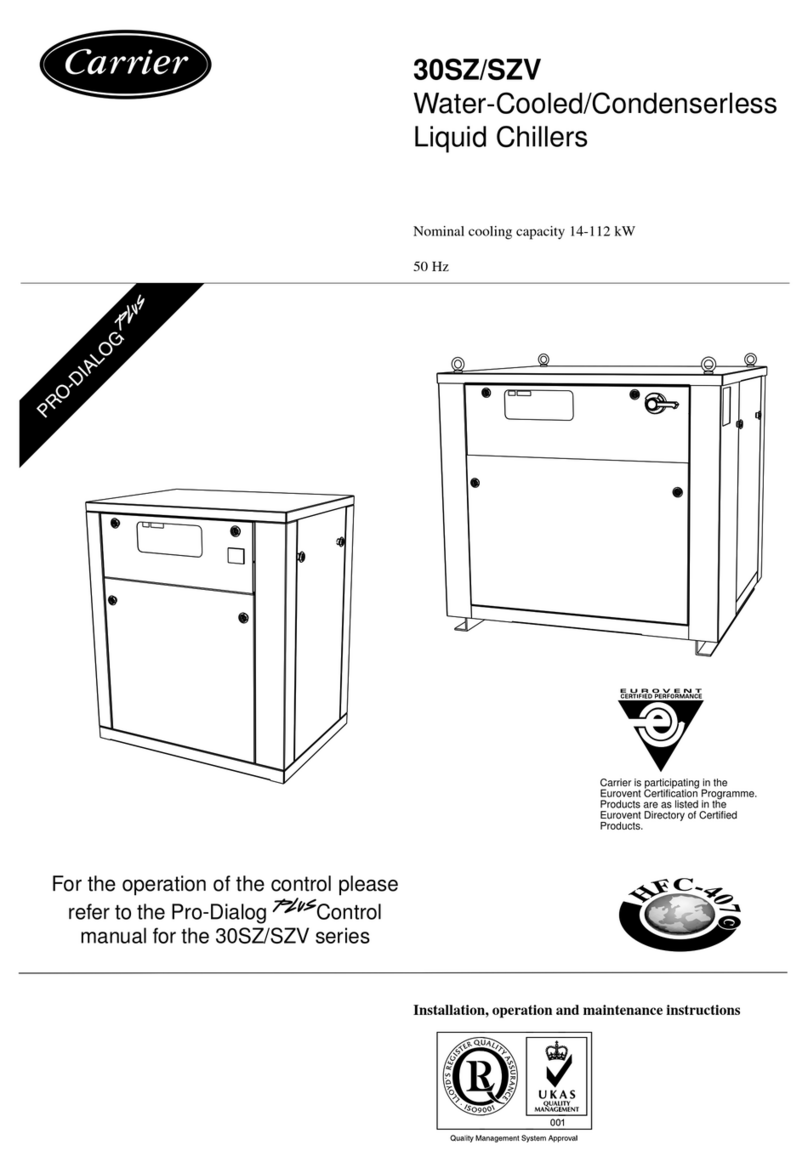
Carrier
Carrier Pro-Dialog Plus 30SZ Installation, operation and maintenance instructions
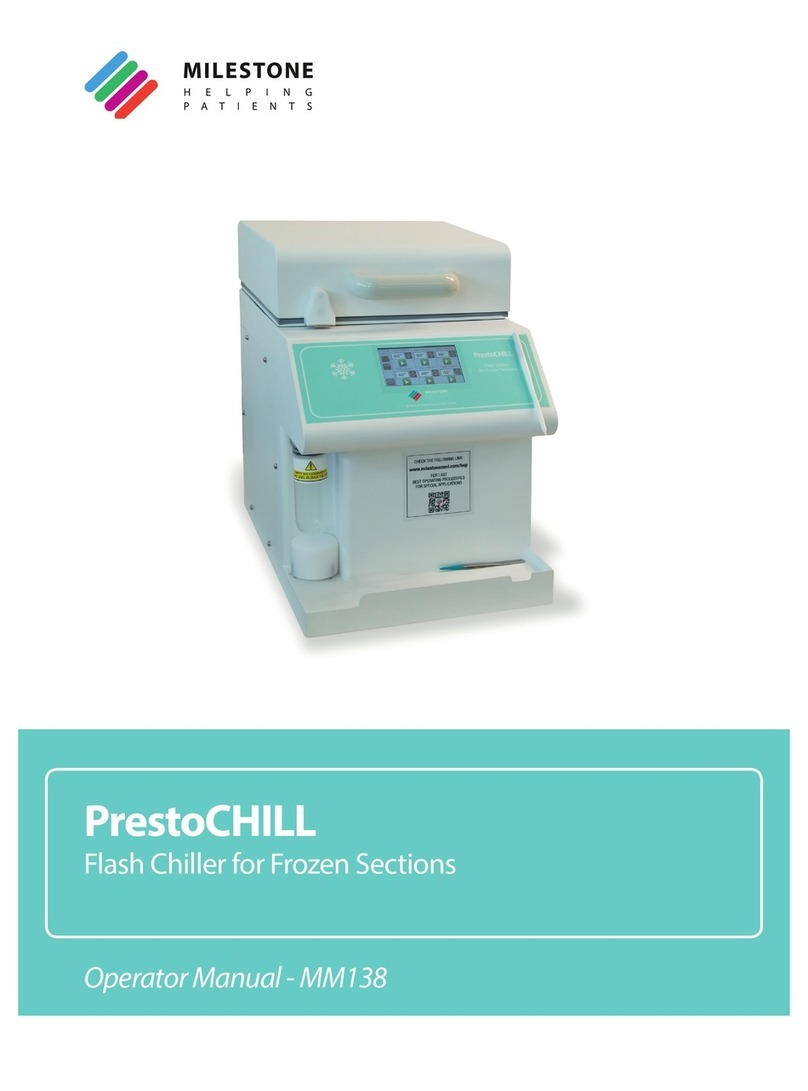
Milestone
Milestone PrestoCHILL Operator's manual

Daikin
Daikin WSC Installation, operation and maintenance manual
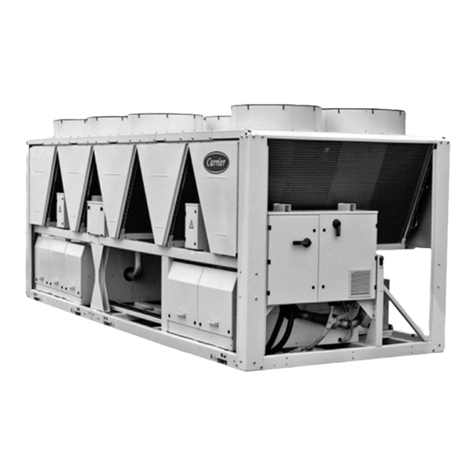
Carrier
Carrier Aquaforce 30XA302 Installation, operation and maintenance instructions

GEA
GEA Grasso DX RR 200 Product information
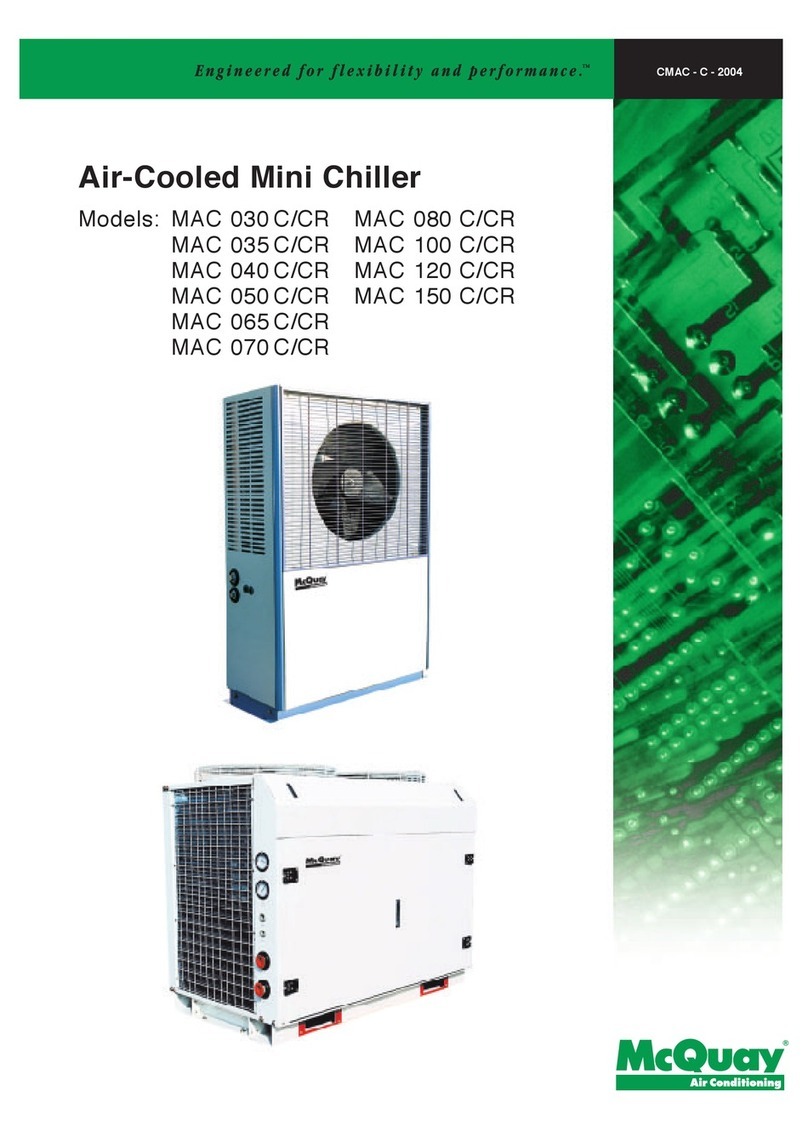
McQuay
McQuay MAC 030 C Installation and Maintenance

